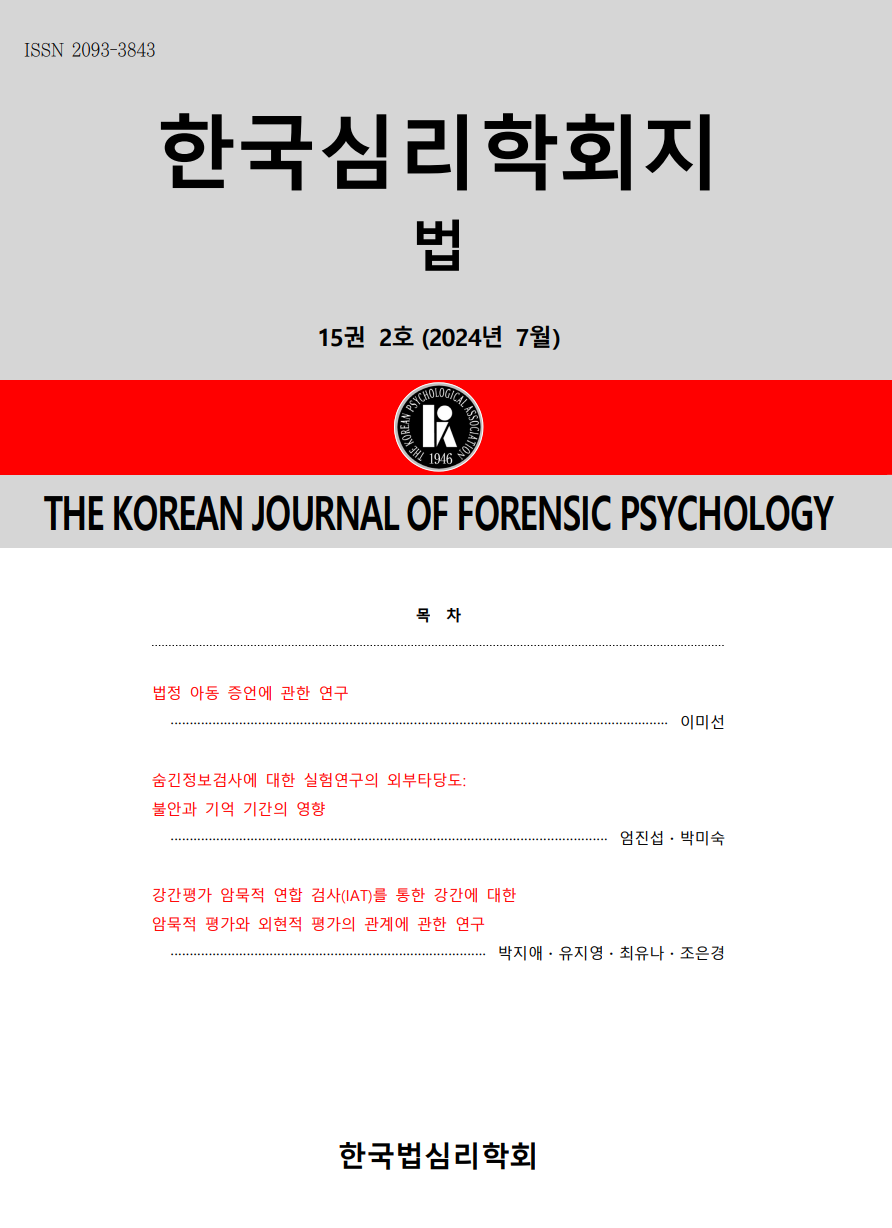open access
메뉴
open access
메뉴 ISSN : 2093-3843
ISSN : 2093-3843
The present study investigated sexual offenses committed in school against persons with disabilities, in terms of offender and victim characteristics, methods of operation, and offense characteristics. A total of 368 sexual offense cases between January 2010 and December 2013 which had been found guilty were collected from 133 legal written decisions. We compared ninety-nine cases against persons with disabilities with 269 cases against persons without disabilities. As a result, there were more male victims in sexual offenses committed in school against persons with disabilities than those against persons without disabilities. Most of offenders in cases against persons with disabilities were teenaged students with no criminal convictions. In addition, most of victims in cases against persons with disabilities were students of the school in which the offense occurred: they were alone in most of the cases at the time of the offense. In general the offender approached the victim by showing affection or giving compliments. The offense occurred in the restroom of the school, mostly in spring. In contrast, most offenders who committed sexual offenses against persons without disabilities were employed: some of them were employees of the school. They tended to plan the offense in advance and approached the victim by using authority. A considerable proportion of the offenses were occurred in elementary school, especially in the playground. Based on the current findings, the present study demonstrates detailed characteristics of the sexual offense cases against persons with disabilities, provides practical strategies for prevention, and aids to make policy implications for preventing crime against persons with disabilities.
박지선, 이연호 (2011). 아동 대상 성범죄자에대한 사람들의 고정관념에 관한 연구, 한국범죄학, 5(2), 81-106.
양형위원회 (2014). 양형기준. 서울: 대법원 양형위원회.
전영실, 이승현, 권수진, 이현혜 (2010). 장애아동, 청소년의 삶의 질 향상을 위한 지원방안 연구Ⅱ: 장애아동, 청소년의 성문제실태 및 대책 연구. 서울: 한국청소년연구원, 한국형사정책연구원.
홍영오 (2008). 2008년 청소년대상 범죄피해 조사연구. 서울: 한국형사정책연구원.
Bass, E. (1983). Introduction: In the Truth Itself, There Is Healing. pp. 23-61 I Never Told Anyone, edited by E. Bass and L. Thornton. New York: Harper and Row.
Belknap, J. (2007). The Invisible Woman: Gender, Crime, and Justice, Belmont, CA: Thomson/Wadsworth.
Browne, A., & Finkelhor, D. (1986). Impact of Child Sexual Abuse: A Review of the research. Psychological Bulletin, 99, 66-77.
Diehl, A. S., & Prout, M. F. (2002). Effects of posttraumatic stress disorder and child sexual abuse on self-efficacy development. American Journal of Orthopsychiatry, 72, 262-265.
Einbender, A. J., & Friedrich, W. N. (1989). Psychological functioning and behavior of sexually abused girls. Journal of Consulting &Clinical Psychology, 57, 155-157.
Finkelhor, D. (1990). Early and long-term effects of child sexual abuse: an update. Professional Psychology: Research & Practice, 21, 325-330.
Finkelhor, D., & Baron. (1986). High Risk Children. pp. 60-88 in A Sourcebook on Child Sexual Abuse, edited by D. Finkelhor. Beverly Hills, CA: Sage.
Heger, A., Ticson, L., Velasquez., & Bernier, R. (2002). Children Reffered for Possible Sexual Abuse. Child Abuse and Neglect, 26, 645-659.
Murphy, S. M., Kilpatrick, D. G., Amick-McMullan, A., Veronen, L. J., Paduhovich, J., Best, C. L., Veilleponteaux, L. A., & Saunders, B. E. (1988). Current Psychological Functioning of Child Sexual Assault Survivors. Journal of Interpersonal Violence. 3, 55-79.
Peters, S, D., Wyatt, G. E., & Finkelhor, D. (1986). Prevalence. pp. 15-59 in Sourcebook on Child Sexual Abuse, edited by D. Finkelhor. Beverly Hills, Ca: Sage.
Putnam, F. W. (2003). Ten-Year Research Update Review: Child Sexual Abuse. Journal of the American Academy of Child and Adolescent Psychiatry, 42, 269-278.
Rush, F. (1980). The Best Kept Secret. New York, NY: Prentice Hall.
Russell, D. E. H. (1984). Sexual Exploitation:Rape, Child Sexual Abuse, and Workplace Harassment. Beverly Hills, CA: Sage.
Sigel, J. A., & Williams, L. A. (2003). Risk Factors for Sexual Victimization of Women. Violence Against Women, 9, 902-930.
Terry, K. J. (2006). Sexual Offenses and offenders. California: Thomson Wadsworth.
Tjaden, P., & Thoennes, N. (1998). Prevalence, Incidence, and Consequences of Violence against Women. U. S. Department of Justice. Research in Brief. November, 16pp.
Williams, L. M., Siegel, J. A & Pomeroy, J. J. (2000). Validity of Women’s Self-Reports of Documented Child Sexual Abuse. pp. 211-226in The Science of Self-Report, edited by Arthur A. Stone, Javlan S. Turkkan, Christine A. Bachrach, Jared B. Jobe, Howard S. Kurtzman, and Virginia S. Cain. Mahwah, NJ: Lawrence Erlbaum.
Wyatt, G. E., Newcomb, M. D., & Riederle, M. H. (1993). Sexual Abuse and Consensual Sex. Newbury Park, CA: Sage.